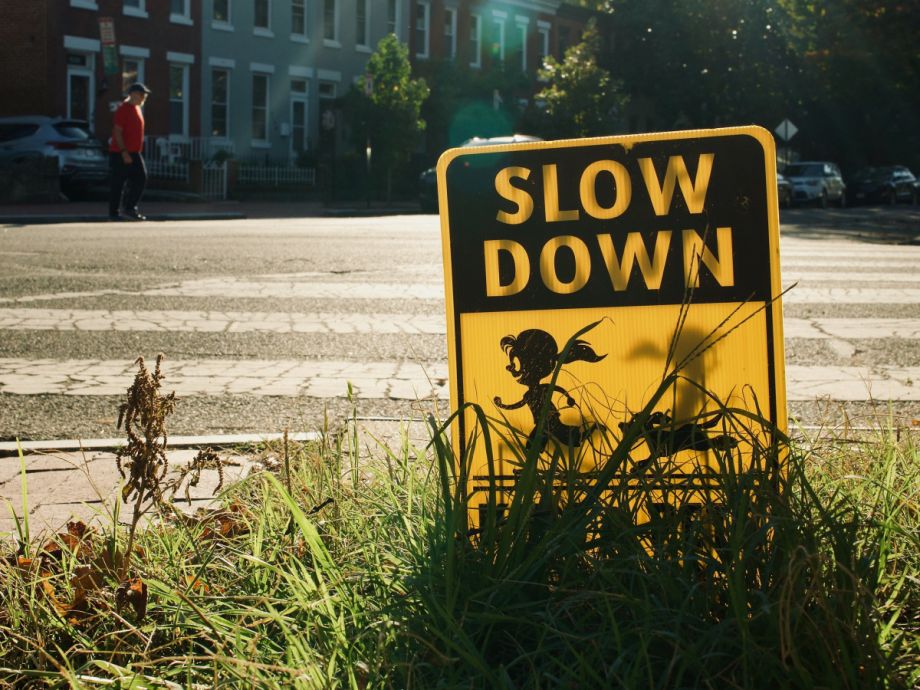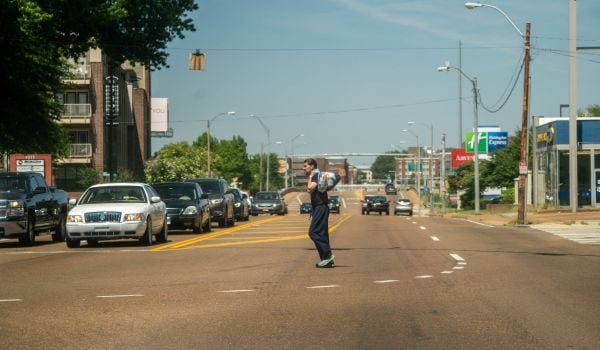On a July night in downtown Austin, a sedan struck two pedestrians, reportedly leaving both with serious injuries. Video published by Fox 7 Austin shows the pair had used a crosswalk and the traffic signal indicated that they had the right of way.
That’s why it seemed especially strange that, in explaining the causes of pedestrian deaths to the local Fox affiliate, the Texas Department of Transportation spokesperson began by describing irresponsible pedestrian behavior. “Pedestrians not paying attention at intersections, not yielding the right of way to other vehicles, or by crossing streets or highways not at crosswalks,” a state official listed. “Likewise from the driver’s side, driver inattention, drivers failing to yield at crosswalks and intersections and failure to control speed.”
The response from the state agency generated a wave of criticism from road safety advocates about how the state talks about safety. “TXDOT: can you tell us how these pedestrians could have been wiser and thus safer? According to the article, they had the right of way and were in the crosswalk,” one Austin resident tweeted.
Dating back to spring 2013, TxDOT has had a road safety campaign dubbed “Be Safe. Drive Smart.” A new component of that campaign urges drivers, pedestrians and bicyclists to follow traffic laws and uses tactics ranging from ads on buses to human billboards, or people standing at busy intersections holding signs.
“Be Safe. Drive Smart.” is a part of the End the Streak initiative – a reference to someone being killed on Texas roads every day since November 2001. The state agency spent $10.32 million in federal funds on the campaign in fiscal year 2022.
That emphasis on bike and pedestrian safety is a response to safety trends in the state. As TxDOT explains on the campaign’s website, 841 pedestrians died on Texas roads in 2021 – a 15% increase compared to the previous year. Pedestrian and bicyclist deaths now account for 20% of road deaths statewide.
“Pedestrians encounter danger any time they walk on or near a roadway. TxDOT encourages pedestrians to remain vigilant and use caution when entering a roadway,” a TxDOT spokesperson told Next City in an email.
The website also lists the top reasons for pedestrian deaths, leading with: “Pedestrians failing to yield the right-of-way to vehicles.” It instructs bicyclists to “use the bike lane if it’s there, or ride as near as possible to the curb.”
This type of language puts the onus on pedestrians and bicyclists, whereas drivers actually cause serious injuries, says Greg Griffin, an associate professor of urban and regional planning at the University of Texas at San Antonio.
“There’s really been very little evidence that suggests that [safety campaigns] are effective in improving safety outcomes,” he says. “Even if there is an improvement, it’s likely to be short-lived, because the campaign has to end. And every year we have a new crop of 16-year-old, or whatever age, drivers that would theoretically not have known.”
Others have echoed Griffin’s criticism. In a Slate article earlier this year, David Zipper, a visiting fellow at Harvard Kennedy School’s Taubman Center for State and Local Government, parsed the evidence on the effectiveness of traffic safety campaigns. He pointed to the successful education campaign to get parents to use car seats: “Campaigns are typically more successful when they share information that is unfamiliar to the intended audience, as the safety benefits of car seats were in the 1970s,” he noted.
A recent study found that some forms of messaging on roads might have unintended consequences as they divert drivers’ attention from the road.
From 2010-2017, it noted a 1.35% increase in crashes 10 kilometers (about six miles) downroad from Texas signs that had displayed traffic fatality stats, suggesting that the signs actually make roads more dangerous. The study, published in the journal Science, also found an increase in on-highway crashes during safety campaign weeks. “Back-of-the-envelope calculations suggest that this campaign causes an additional 2600 crashes and 16 fatalities per year in Texas alone,” the researchers concluded.
TxDOT still sees value in its messaging campaigns. The state agency cites the Click It or Ticket initiative as an example of an effective safety campaign. A spokesperson told Next City that the National Highway Traffic Safety Administration estimates it saved 6,972 lives and $26.3 billion in related economic costs from 2002 to 2019. The campaign was successful, the TxDOT representative said, because it combined “enforcement, education, and media outreach.”
Griffin, the urban planning professor, grew up riding bikes and racing BMX, but his epiphany about road design came when he was a master’s student in San Marcos, Texas. Walking to grab lunch one day, he looked around and noticed that he was the only pedestrian on the street. “Everybody else is hunched inside cars, and I’m thinking there’s something wrong with this,” he recalls. “There’s something wrong with our cities.”
Griffin has extensive experience working with TxDOT, as he previously worked for the Texas A&M Transportation Institute, a state agency that often collaborates with TxDOT for research initiatives. He argues that TxDOT could make more impactful safety investments by improving infrastructure. While the state agency lists safety as its number one priority, it only dedicated around 4% of its funds to safety initiatives in its 10-year plan.
“We have entire systems of streets that have zero sidewalks on them,” he says. “We have a huge lack of bicycle lanes. We have arterial streets that lack center turn lanes and medians that are all proven to be able to reduce the likelihood of a crash.”
Jay Blazek Crossley, executive director of the Austin-based land use nonprofit Farm & City, has been at the forefront of advocacy for safer roads in Texas. While he sees room for criticism in the “Be Safe. Drive Smart.,” he also sees a sliver of optimism in how the state has slowly evolved its approach to road safety messaging.
“Some of the messaging is directly talking to each of us when we are making choices or driving or doing something and having safety messaging treating people with respect, as the decision-makers in the transportation system I think actually is very important,” Blazek Crossley says.
He adds that TxDOT investing in safe, multimodal streets is the most important thing that it can do to make roads less dangerous. For example, sections of I-35 in Austin have one-to-two-mile stretches without crossings.
In addition to infrastructure changes, Blazek Crossley said there is opportunity for safety improvements through policy changes. The Lisa Torrey Smith Act passed during the 2021 Texas Legislative Session requires drivers to stop and yield to pedestrians in crosswalks.
Blazek Crossley sees potential to build on that momentum, referring to “a paradigm shift in transportation policy” in the state.
TxDOT updated its roadway design manual to include a pedestrian design section and changes to the bikeway design section. The Texas House and Senate committees on transportation are both supposed to present safety solutions during the 2023 legislative session, he adds.
Local initiatives in cities throughout the state have also shown signs of promise. Joe Cutrufo, executive director of BikeHouston, pointed to the Bayou Greenways project as an example of investment in Houston’s bikeways. The $220 million public-private partnership aims to provide 150 miles of trails connecting the city’s bayous.
Like Blazek Crossley, Cutrufo is hopeful that policy advances can be made at the upcoming legislative session, including a bill allowing cities to lower citywide speed limits. But when it comes to TxDOT, Cutrofo questions its sincerity around safety issues.
“It’s painfully obvious that a person driving a two-ton motorized vehicle is capable of so much more damage than someone riding a 30-pound bicycle,” he says. “I can’t believe I have to say that, but when you look at TxDOT’s literature it seems like maybe they’ve forgotten that.”
This story has been updated to correct the spelling of Cutrufo’s name.
Benton Graham is a freelance writer based out of Austin, Texas. He has covered mobility for the Austin Chronicle and Community Impact.




_600_350_80_s_c1.jpg)











